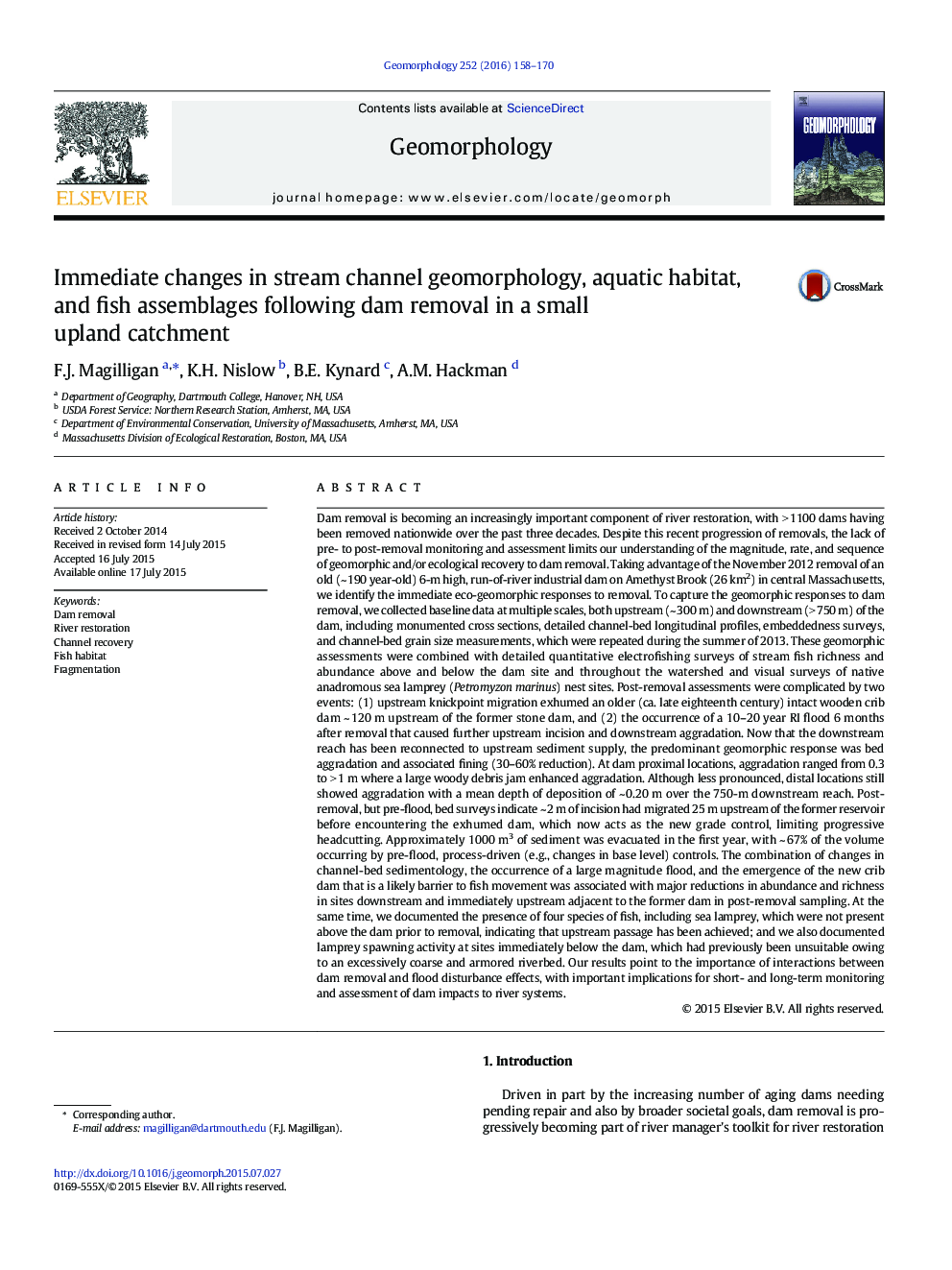| کد مقاله | کد نشریه | سال انتشار | مقاله انگلیسی | نسخه تمام متن |
|---|---|---|---|---|
| 4684133 | 1635397 | 2016 | 13 صفحه PDF | دانلود رایگان |
• Re-connected sediment flux led to downstream aggradation and bed fining
• Natural and anthropogenic controls limited upstream impacts
• The ecological response was related to the new sediment flux and barrier removal
• Dam removal led to the upstream extension of native fish species
• Extreme flow events can complicate the short-term ecological response to dam removal
Dam removal is becoming an increasingly important component of river restoration, with > 1100 dams having been removed nationwide over the past three decades. Despite this recent progression of removals, the lack of pre- to post-removal monitoring and assessment limits our understanding of the magnitude, rate, and sequence of geomorphic and/or ecological recovery to dam removal. Taking advantage of the November 2012 removal of an old (~ 190 year-old) 6-m high, run-of-river industrial dam on Amethyst Brook (26 km2) in central Massachusetts, we identify the immediate eco-geomorphic responses to removal. To capture the geomorphic responses to dam removal, we collected baseline data at multiple scales, both upstream (~ 300 m) and downstream (> 750 m) of the dam, including monumented cross sections, detailed channel-bed longitudinal profiles, embeddedness surveys, and channel-bed grain size measurements, which were repeated during the summer of 2013. These geomorphic assessments were combined with detailed quantitative electrofishing surveys of stream fish richness and abundance above and below the dam site and throughout the watershed and visual surveys of native anadromous sea lamprey (Petromyzon marinus) nest sites. Post-removal assessments were complicated by two events: (1) upstream knickpoint migration exhumed an older (ca. late eighteenth century) intact wooden crib dam ~ 120 m upstream of the former stone dam, and (2) the occurrence of a 10–20 year RI flood 6 months after removal that caused further upstream incision and downstream aggradation. Now that the downstream reach has been reconnected to upstream sediment supply, the predominant geomorphic response was bed aggradation and associated fining (30–60% reduction). At dam proximal locations, aggradation ranged from 0.3 to > 1 m where a large woody debris jam enhanced aggradation. Although less pronounced, distal locations still showed aggradation with a mean depth of deposition of ~ 0.20 m over the 750-m downstream reach. Post-removal, but pre-flood, bed surveys indicate ~ 2 m of incision had migrated 25 m upstream of the former reservoir before encountering the exhumed dam, which now acts as the new grade control, limiting progressive headcutting. Approximately 1000 m3 of sediment was evacuated in the first year, with ~ 67% of the volume occurring by pre-flood, process-driven (e.g., changes in base level) controls. The combination of changes in channel-bed sedimentology, the occurrence of a large magnitude flood, and the emergence of the new crib dam that is a likely barrier to fish movement was associated with major reductions in abundance and richness in sites downstream and immediately upstream adjacent to the former dam in post-removal sampling. At the same time, we documented the presence of four species of fish, including sea lamprey, which were not present above the dam prior to removal, indicating that upstream passage has been achieved; and we also documented lamprey spawning activity at sites immediately below the dam, which had previously been unsuitable owing to an excessively coarse and armored riverbed. Our results point to the importance of interactions between dam removal and flood disturbance effects, with important implications for short- and long-term monitoring and assessment of dam impacts to river systems.
Journal: Geomorphology - Volume 252, 1 January 2016, Pages 158–170
